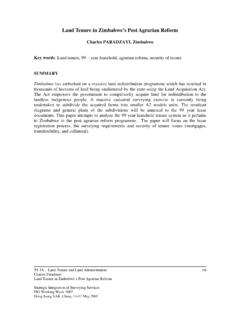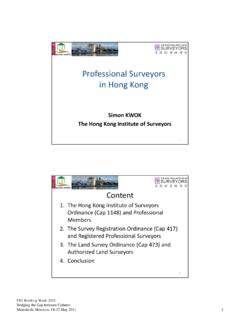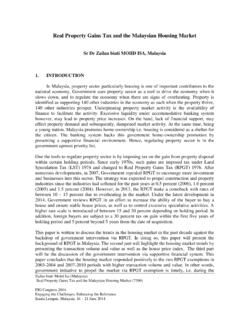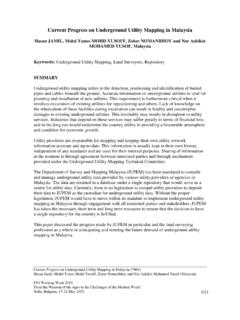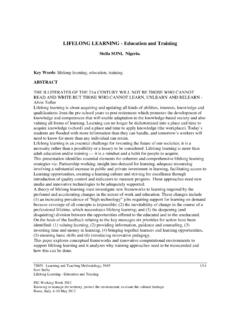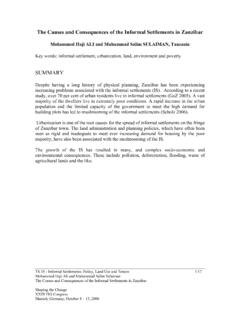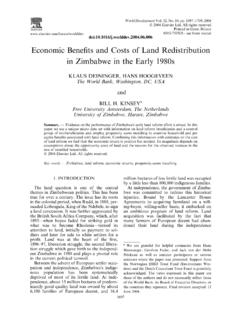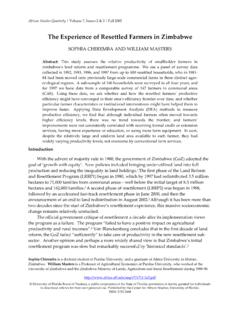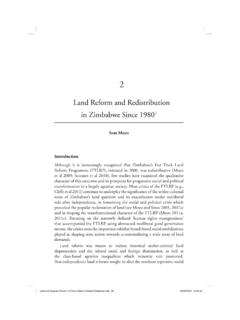Transcription of A Critical Analysis of the Land Reform Programme …
1 TS4 Management of land Francis Chitsike A Critical Analysis of the land Reform Programme in zimbabwe 2nd FIG Regional Conference Marrakech, Morocco, December 2-5, 2003 1/12A Critical Analysis of the land Reform Programme in zimbabwe Francis CHITSIKE, zimbabwe Key words: land Reform , Implementation, land Information System, Cadastre, Sustainable Development. SUMMARY The land Reform Programme in zimbabwe has been a major area of international discussion for almost five years now; mainly due to the hitherto unprecedented approach taken by the government of zimbabwe to address this very emotive issue. From the world s marginalized communities there has been a lot of admiration for such a bold move, while there has been condemnation from other sections of the international community who sympathise with those perceived to be at the losing end of this exercise. This paper takes a Critical look at the issues surrounding the land Reform Programme .
2 It investigates the historical background to land ownership in zimbabwe before and after independence from colonial rule. The paper will also look at the zimbabwe government s land policy since 1980 and what has influenced same. The legal framework under which this exercise is proceeding will also come under scrutiny. The government policy will then be evaluated against the Global Plan of Action of the Habitat II agenda, to which the government is a signatory. Finally the paper will question the actual implementation of the land Reform Programme , with the aim of drawing lessons from the Zimbabwean experience. TS4 Management of land Francis Chitsike A Critical Analysis of the land Reform Programme in zimbabwe 2nd FIG Regional Conference Marrakech, Morocco, December 2-5, 2003 2/12A Critical Analysis of the land Reform Programme in zimbabwe Francis CHITSIKE, zimbabwe 1.
3 INTRODUCTION At independence in 1980 zimbabwe inherited a highly skewed pattern of land distribution. A small minority of white large-scale commercial farmers owned and farmed most of the better agricultural land . The majority of the national population, made up exclusively of black Zimbabweans, farmed in the lower rainfall and poorer soil areas. This dual structure of land ownership was a result of various pieces of legislation introduced during the colonial era, which resulted in mass expropriation of prime agricultural land by the colonial settlers and the subsequent marginalization of black people into reserves now known as communal areas. The issue of access to land was therefore a major rallying point that led to the war of liberation. After protracted negotiations between the liberation armies and the newly elected Conservative Government led by Mrs Margaret Thatcher, the Lancaster House Agreement was finally reached.
4 More than a hundred years ago, in 1890, British forces occupied a part of Southern Africa that is now known as zimbabwe . A year earlier the white settlers had been given rights to the land of indigenous people. The British South Africa Company had been formed to buy concessions from the British Crown and this formed the basis of the subsequent land grabbing by the settlers. Over the next ten years or so, as the take-over of land unfolded, white settlers hemmed in the majority black population on what they called Native Reserves (known today as communal areas). This marked the beginning of the division of the Africans land . They got small, largely infertile tracts of land while expropriated land in the hands of white farmers was the biggest and the best. Surveyors were sent in to peg out the new farms and title deeds were issued to the new settlers. Conquest through land grab and livestock seizure brought stiff resistance from the indigenous people.
5 The first major uprising (known as the First Chimurenga) soon exploded in 1893. It was bloodily suppressed its leaders and instigators executed. However the tide that would turn against the settlers today was rising. In a relatively short period of time up to 1914 the division of land became vastly disproportionate. Just three percent of the population controlled seventy-five percent of the land , while most of the rest were restricted to a mere twenty-three percent of the worst land in designated reserves. There were only 28,000 white settlers to nearly one million Africans in zimbabwe at that time. In the ensuing years various pieces of legislation were passed which sought to protect and strengthen the huge privately owned settler farms that were largely situated in high rainfall areas. The growing black population could hardly eke out a living on the generally poor soils in the communal areas.
6 Discontent gradually took shape within the liberation movement, which emerged as a major challenge to the status quo in the early 1960 s. The armed struggle TS4 Management of land Francis Chitsike A Critical Analysis of the land Reform Programme in zimbabwe 2nd FIG Regional Conference Marrakech, Morocco, December 2-5, 2003 3/12(now referred to as the Second Chimurenga) moved from the towns into the villages and communal areas, involving peasant communities in the national uprising. The Second Chimurenga culminated in the Lancaster House conference in 1979, which led to the birth of the Republic of zimbabwe on 18 April 1980. 2. land RESETTLEMENT 1980-1996 Policy Objective Figures 1 and 2 below summarise how land was distributed for agricultural production at independence. Figure 1: Number of Farmers (1980)70000067008500 Large ScaleCommercialFarmersSmall Scale FarmersCommunal AreaFarmers Figure 2: land Area (Million Hectares) ScaleCommercialFarmersSmall Scale FarmersCommunal AreaFarmers land redistribution was high on the list of priorities for the new Government in 1980.
7 Soon after coming into power the Government established an Intensive Resettlement Programme . The specific objectives of the resettlement Programme were summarised as: - To alleviate population pressure in the Communal Areas; To extend and improve the base of productive agriculture in the peasant farming sector, through individuals and cooperatives; To improve the standard of living of the largest and poorest sector of the population of zimbabwe ; To ameliorate the plight of people who have been adversely affected by the war and to rehabilitate them; To provide, at the lower end of the scale, opportunities for people who have no land and are without employment and may therefore be classed as destitute; To bring abandoned and under-utilised land into full production as one facet of implementing an equitable policy of land redistribution; To expand and improve the infrastructure and services that are needed to promote the well being of people and economic production.
8 To achieve national stability and progress in a country that has only emerged from the turmoil of war. TS4 Management of land Francis Chitsike A Critical Analysis of the land Reform Programme in zimbabwe 2nd FIG Regional Conference Marrakech, Morocco, December 2-5, 2003 4/12 These objectives guided the implementation of the Intensive Resettlement Programme up to 1990. The Government did not rank the objectives in any order of priority but it was left to the implementing agencies to decide which objectives took precedence over others. In light of the experience gained during the first ten years of Programme implementation the objectives were revised in the new National land Policy of 1990 as follows: - To resettle deserving and landless people; To extend and improve the base of productive agriculture in the small scale farming sector, through the provision of training and extension for the promotion of good husbandry and social development; To alleviate population pressure in the Communal Areas through an integrated linkage between resettlement and Communal Area reorganisation and development; To improve the standard of living of the largest and previously disadvantaged sector of the population through the provision of infrastructure and services and the execution of a resettlement Programme that will ensure the attainment of sufficiently high levels of income.
9 An initial target was set in 1980 to resettle about 18,000 families on million hectares of land over a five-year period. This was revised in 1982 to 162,000 families on 9 million hectares. In the new land Policy of 1990 the hectarage was further revised to million hectares, maintaining the same target population. The new National land Policy also established the Government s strategic objective for the sizes of the various land tenure regimes. These are summarised in Figure 3 below. Figure 3: land Distribution (1980 vs Target)Resettlement State Owned FarmsLarge Scale CommercialCommunal AreasNational Parks / Urban Small Scale Commercial024681012141618 Million HectaresArea at 1980 (MillionHectares)Target Area as set in1990 land Policy Four types or models of resettlement were used at the outset of the Programme : Model A, involving a village as a nucleus with individual arable holdings and communal grazing within the village boundaries.
10 Settler families were allocated residential stands, about 5 hectares of land for arable purposes and access to communal TS4 Management of land Francis Chitsike A Critical Analysis of the land Reform Programme in zimbabwe 2nd FIG Regional Conference Marrakech, Morocco, December 2-5, 2003 5/12grazing. The schemes were provided with access roads linking all villages with a rural service centre at which Government service staff (agricultural extension, health and education workers and resettlement officers) were based. Model B scheme, involving the formation of cooperatives to manage purchased farms on a collective basis. This model was supposed to be selected for properties with developed infrastructure ( irrigation or infrastructure for specialised agricultural enterprise). Model C schemes patterned on the nucleus estate concept with a core commercial estate and/or processing facility and settler outgrowers.
